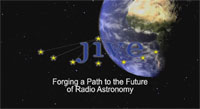What is VLBI?
Let's begin with traditional (non-e) VLBI. Very Long Baseline Interferometry (VLBI) is an astronomical technique in which radio telescopes hundreds or thousands of kilometres apart cooperate to form a single telescope. By processing the digitized signals with a central, dedicated super-computer, astronomers are able to produce images of the sky with a resolution that surpasses that of the best optical telescopes, even the Hubble space telescope.
Why is VLBI useful?
The technique can be used to study a wide variety of astronomical phenomena, from the energetic outflows associated with black holes in the centres of galaxies at cosmological distances to the details of the dynamical processes in star forming regions in our Galaxy. Besides observing natural phenomena like exploding stars and gravitational lenses, VLBI has also been applied to measure the detailed position of man-made spacecraft on their journeys through the solar system, for example during the descent of the Huygens spacecraft to the surface of Saturn’s moon Titan.
What's wrong with VLBI?
Traditional VLBI relies on recording sampled data from each telescope onto hard disk and physically shipping those disks to the correlator for processing. This can take weeks for the astronomer to receive his or her processed data. It also means that if there were problems with a telescope's settings during the observation, all data from that particular station is useless.
What is e-VLBI?
With e-VLBI, or electronic VLBI, the sampled data is streamed directly from the telescope to the correlator over fibre optic networks and correlated in real-time. There are three main benefits. First, problems at the telescope can be recognised and corrected during the observation itself. Second, the astronomer receives his or her processed data in a matter of hours rather than weeks. Third, if so-called transient activity, such as a supernova or gamma-ray burst is detected, follow-on observations can be scheduled immediately.
